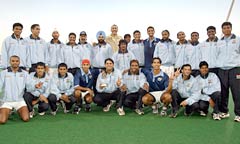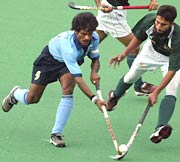
There is a cycle -- time-honored, immutable -- in Indian sport. It goes thus:
1. Win something minor
2. Sing hosannas
3. Talk up a storm about the probability of medals on the world stage in that discipline
4. Go for world level tournament
5. Lose
6. Find excuses
7. Win something minor...
Indian hockey has won nothing of note since the 1998 Asian Games gold and the Junior World Cup in 2001 -- hence, when the team wins two tournaments abroad, some celebration is in order.
But surely, that celebration has to be proportionate to the successes achieved, in Sydney and Hamburg. At Sydney, India won the second leg of the three-nation Australia Men's Challenge, which involved the hosts and Pakistan. A look at the results will show that India beat Australia 'A' 4-3, while drawing with Australia (3-3) and Pakistan (4-4) in the league phase; it then beat Australia 5-3 in the final.
At Sydney, India won the second leg of the three-nation Australia Men's Challenge, which involved the hosts and Pakistan. A look at the results will show that India beat Australia 'A' 4-3, while drawing with Australia (3-3) and Pakistan (4-4) in the league phase; it then beat Australia 5-3 in the final.
Hamburg was a four-nation event involving the hosts, who hold the title of world champions, Spain and Argentina. While India lost to Germany 2-3, it won against Argentina (4-1) and Spain (4-2). India also held Germany in the one-off Test that was played prior to the tournament.
So applaud -- but it pays to keep in mind that like India, the other teams on view were treating these tournaments as testing grounds for new permutations and combinations, ahead of the Champions Trophy in August.
Australia fielded two teams, shuffling 36 players in the two legs, the first of which was in Perth. Germany did the same; except that it also fielded some of their experienced players like Florian Kunz, Sascha Reinalt and Michael Green. Spain and Argentina, both of whom will figure in the Champions Trophy, used the tournament to try out new players.
All of which necessitates a revision of current hype -- India won, and that is good; India did not win an Olympic or world level tournament, and that is a thought to keep firmly in mind.
This is not an attempt to rain on the team's parade -- rather, a timely reminder that in the past, India has excelled in outings prior to major events, only to deceive when the rubber met the road. It happened before the Sydney Olympics, then again before the World Cup.
Before the Sydney Olympics, India won the four-nation tournament in Perth. And when coach Bhaskaran was reminded by this correspondent a few weeks later that the Aussies were trying out different players in the tournament, he shot back: "That's a problem with journalists. When we beat somebody they say they were not all full strength; when we lose they say we are no good. When we win they say this and that. That means our journalists don't want India to win. Straight away I will tell you. Because if India loses they can write more stories. They can write I was not in the room; he was not in the room. They can fill up gossip..."
 Same was the case before the World Cup in Kuala Lumpur. In 2001 India won the Champions Challenge, also in Kuala Lumpur, which involved teams like South Africa, Argentina, Belgium, Malaysia and Japan. No Australia, Germany, Holland or South Korea. When the team returned, there was the usual hype like we are now witnessing. And then what happened at the World Cup? India ended up a poor tenth among 16 teams, and the coach of the team was dumped midway through the tournament.
Same was the case before the World Cup in Kuala Lumpur. In 2001 India won the Champions Challenge, also in Kuala Lumpur, which involved teams like South Africa, Argentina, Belgium, Malaysia and Japan. No Australia, Germany, Holland or South Korea. When the team returned, there was the usual hype like we are now witnessing. And then what happened at the World Cup? India ended up a poor tenth among 16 teams, and the coach of the team was dumped midway through the tournament.
In both cases -- and this is another good reason for sounding the note of caution -- teams went to the major tournaments over-hyped; on both occasions, inflated expectations were not met; on both occasions, the coaches concerned were axed.
From this perspective, it would have been nice if senior stars, such as Dhanraj Pillay, Prabjot Singh and Gagan Ajit Singh had been used sparingly in these two tournaments -- partly to keep them injury free, partly to give the bench a good go.
Mercifully, injury did not become a factor, if you ignore the fact that Gagan Ajit needed stitches on his ear following a clash with a player in the game against Argentina.
This is not to say the showing was ordinary -- far from it. In Australia, the Indian team was up against opposition that played the same style of hockey as their own; in Hamburg it was the European style of hard-running, power hockey.
To the team's credit, they matched the opposition in speed, fitness and finesse. Coach Rajinder Singh's recipe of youth with a sprinkling of experience is, on this evidence, working. With almost the same bunch of youngsters who formed part of his Junior World Cup-winning side, Rajinder, a member of the gold medal-winning 1980 Olympics team, struck the right balance of speed and skill.
In Pillay, Baljit Singh Dhillon and Baljit Saini -- the last two recalled to the side after the Kuala Lumpur World Cup -- Rajinder has the much-needed experience that the team requires.  At the World Cup, it was the defence that was often found wanting. Dilip Tirkey, Kanwalpreet Singh and Jugraj Singh have come a long way since then; they are now more assured and solid.
At the World Cup, it was the defence that was often found wanting. Dilip Tirkey, Kanwalpreet Singh and Jugraj Singh have come a long way since then; they are now more assured and solid.
The midfield has been a revelation; one factor could be that most of the players had played together before in the Junior World Cup. Bimal Lakra, who was unlucky not to make it to the Sydney Games and the World Cup, has been a glutton for hard work. Along with Ignace Tirkey, Viren Rasquinha, Vikram Pillay and Baljit Saini, they made a formidable link line.
Upfront there is the evergreen Pillay, Baljit Dhillon, Prabhjot Singh, Gagan Ajit, Sandeep Michael and Deepak Thakur to pick from -- all have speed and guile, though they need to sharpen their finishing from field play. Gagan Ajit Singh in particular, who led the Junior World Cup-winning team, was adjudged player of the Hamburg tournament.
All of which is to the good, and indicative of the slow, but sure, renaissance of Indian hockey in recent times. It pays, though, to remember ahead of the Champions Trophy that the real tests are yet to come.








